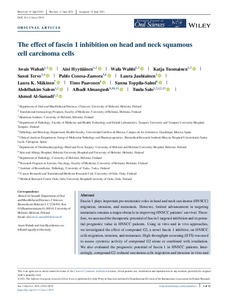The effect of fascin 1 inhibition on head and neck squamous cell carcinoma cells
Jauhiainen Laura; Toppila-Salmi Sanna; Almangush Alhadi; Mäkinen Laura K.; Hyytiäinen Aini; Conesa-Zamora Pablo; Tuomainen Katja; Salem Abdelhakim; Salo Tuula; Tervo Sanni; Al-Samadi Ahmed; Wahbi Wafa; Wahab Awais; Paavonen Timo
https://urn.fi/URN:NBN:fi-fe2022081153753
Tiivistelmä
Fascin 1 plays important pro-metastatic roles in head and neck carcinoma (HNSCC) migration, invasion, and metastasis. However, limited advancement in targeting metastasis remains a major obstacle in improving HNSCC patients' survival. Therefore, we assessed the therapeutic potential of fascin 1 targeted inhibition and its potential prognostic value in HNSCC patients. Using in vitro and in vivo approaches, we investigated the effect of compound G2, a novel fascin 1 inhibitor, on HNSCC cells migration, invasion, and metastasis. High-throughput screening (HTS) was used to assess cytotoxic activity of compound G2 alone or combined with irradiation. We also evaluated the prognostic potential of fascin 1 in HNSCC patients. Interestingly, compound G2 reduced carcinoma cells migration and invasion in vitro and inhibited metastasis in vivo. Moreover, HTS revealed a modest cytotoxic activity of the compound G2 on HNSCC cell lines. Irradiation did not synergistically enhance the compound G2-mediated cytotoxic activity. Survival analyses showed that high fascin 1 immunoexpression, at the tumor invasive front, was associated with cancer-specific mortality in the advanced stages of HNSCC. Collectively, our findings suggest that fascin 1 represents a promising anti-metastatic therapeutic target and a useful prognostic marker in patients with HNSCC. Novel anti-metastatic agents could provide a valuable addition to cancer therapy.
Kokoelmat
- Rinnakkaistallenteet [19207]
